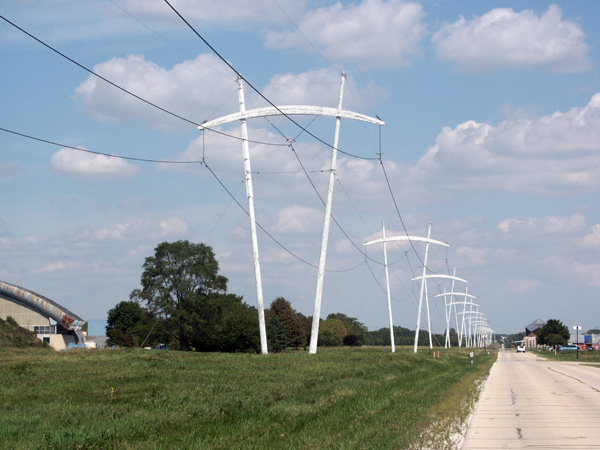Aging Utility Poles

NAL's distinctive power poles cross the Illinois prairie. Photo by Nadezhda Shemyakina, August 31, 2004
Running north from Wilson Hall is a row of utility poles so spare in shape they look like sculptures by Giacometti--whimsical larger-than-life birds with long legs and outspread wings, peeling off to the horizon. They bring in the power that makes our protons go 'round.
Robert Wilson, Fermilab's founding director, designed the utility poles to resemble the Greek letter pi. Pi is, of course, a ubiquitous symbol in particle physics (and in math). It is that magical relationship between the diameter of a ring and its circumference, and the root name of those strange particles from cosmic rays that spill into our atmosphere unannounced.
Wilson wasn't being cute when he designed the poles. He just wanted to make utility poles that weren't as ugly as the ones that commonly line American roads. "I went to Commonwealth Edison and told them I wanted to design my own power poles," Wilson once recounted. "They were outraged. After a lot of fighting, the power company gave in. I'm surprised that my poles never caught on. They really are prettier."
The fight Wilson referred to involved questions of practicality: Whatever Commonwealth Edison thought of their aesthetics, it wasn't convinced the poles would be functional, and the company required full-scale testing to ensure that the poles could carry any anticipated load. Fermilab was allowed to erect the poles only when the testing proved them fit.
Over the years, the poles have drawn still more trouble. The poles were never capped, which left their tops subject to the elements.
In 1986, and again in 1991 and 1992, sound (and other) tests were done to determine whether the poles were deteriorating. Inspectors tapped them with mallets--a nice ring meant the douglas fir was solid inside; a dull thud signaled the wood was rotting away. Ultrasonic tests were also done in which a transmitter was placed on one side of a pole and a receiver on the other, and the velocity of the sound wave measured as it passed through the wood. The news was not reassuring.
"Heart rot" had set in. Black ants had invaded. Woodpeckers had chipped away, digging for insects. Fungi with long Latin names were taking over.
Good poles were treated with a combination pesticide-fungicide, bad ones with copper naphthenate. Sections were swathed in chicken wire to ward off the woodpeckers, who subsequently flew these coops. Fused rods made of boron, a toxic substance, were inserted to stem the spread of fungi.
At one point, even researchers in the Forest Service, under the U.S. Department of Agriculture, took interest in helping out, but after running samples of wood borings to identify the sources of the trouble, their funding dried up.
All the attention on these unique utility poles could not reverse the damage, but it did extend their useful life. A three-year, $2.5-million project to replace them won't have to begin until 2002.


